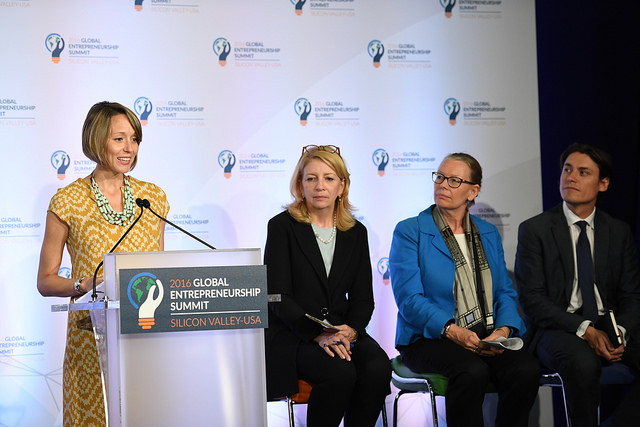Weekly Roundup is a McNair Center series compiling and summarizing the week’s most important Entrepreneurship and Innovation news.
Here is what you need to know about entrepreneurship this week:
Anne Dayton, Research Manager, McNair Center
The 115th Congress has passed 3 bills this legislative session relating to entrepreneurship and innovation. The tally seems abnormally high considering that only 10 bills have been passed in total since Congress first convened on January 3rd, While this wave of legislation might appear to indicate that Congress has set its sights on promoting entrepreneurship and innovation, the McNair Center’s Anne Dayton notes that out of the three bills passed by Congress, only one substantiates effective policy.
Out of the three bills passed, Dayton highlights the TALENT Act as likely to “make a real world impact.” The TALENT Act essentially codifies and formalizes the Presidential Innovation Fellows program, an initiative originally introduced by President Obama. The bill falls under House Majority Leader McCarthy’s Innovation Initiative for spurring higher rates of innovation in the private sector. For more insight into the work done by Innovation Fellows, check out Julia Wang’s post for the McNair Center on President Obama’s efforts to generate an “innovation nation.”
The other two acts, Promoting Women in Entrepreneurship and INSPIRE, aim to support women in entrepreneurship but are unfortunately, according to Dayton, “devoid of meaningful changes to public policy.” If you’re interested in how policy can increase women in STEM and innovation-based fields, check out this post from McNair’s Tay Jacobe.
Notwithstanding the results of the recent legislation, Dayton acknowledges that “all three acts passed Congress with bipartisan support”; hopefully these unified efforts are a function of “a shared interest in furthering innovation in government and expanding access to careers in entrepreneurship and STEM” among U.S. politicians.
Katie Benner, The New York Times, Reporter
Bill Gurley is a general partner at prominent Silicon Valley VC firm, Benchmark. Gurley spotted Uber early on, claiming a 20 percent stake in the successful ride-hailing app six years ago. Since Benchmarks original investment in Uber in 2011, the startup’s value increased 1,100-fold. Despite the startup’s huge successes, Uber has run into a host of problems in recent weeks, including legal disputes, stiff competition from rival ride-sharing app Lyft and negative press attention for employee allegations of sexual harassment and discrimination.
In light of the startup’s series of blunders, Gurley decided to take a more hands-on approach in advising Uber’s damage control strategy and will reportedly assist in the search for a COO for the startup. Since joining Benchmark, Gurley has been involved in the firm’s profitable investments into GrubHub, OpenTable and Zillow. However, with a successful public offering, Uber could become Gurley’s greatest tech investment yet.
Gurley is famous in Silicon Valley for his often unorthodox and unpopular advice to successful tech firms. During the dot com boom, he advised tech startup Net Gravity to go public as soon as possible, rather than to delay their IPO for further funding rounds. According to Gurley, “taking on too much venture funding…can fuel a lack of discipline” and lead to the absence of “rigorous financial and operational controls” among startups.
Diane Mulcahy, Harvard Business Review, Reporter
Harvard Business Review’s Mulcahy reports on the potential of the gig economy going forward. In a traditional economy, companies demand employee attendance – in other words, the five day, eight-hour workweek. Under a gig economy, however, companies value employee performance over attendance and allow employees to disconnect their work from the office space. Options that allow employees to work remotely or in co-working spaces cut real-estate costs for employers and provide productive and flexible work environments for employees.
According to Mulcahy, “the most impactful lesson that traditional companies can learn from the gig economy is to judge all workers, including employees, on their results, not on when and where they do their work.” Perhaps entrepreneurs and startups might take a hint from the benefits of the gig economy. For most firms, and especially small businesses, labor is the most costly input into the production process. In fact, according to a study from CBRE, the average U.S. company spends roughly $12,000 per employee per year on office space alone. A survey of 8,000 employees conducted by McKinsey’s Global Institute reveals that employees who work outside of the typical office lifestyle report higher levels of satisfaction and productivity.
Mikey Tom, PitchBook, Contributor
PitchBook’s Tom covers MuleSoft’s IPO from last Friday. The IPO secured the VC-backed startup a market cap slightly above $3 billion. Mulesoft is 2017’s first large tech enterprise to go public. The San Francisco-based company develops software platforms that integrate data, devices, and APIs (application programming interfaces). Although 2016 was a slow year for public offerings (in comparison to M&A deals), Tom predicts that 2017 could reverse this current trend in VC exits. Tom predicts that the market’s “warm” reception to Mulesoft public offering could signal a shift in the “public market’s appetite for enterprise.” Just last week, tech unicorn Okta filed for its IPO. Okta provides identity management technologies, a hot sector in the tech industry right now.
Josh Constine, TechCrunch, Reporter
Music-streaming startup Spotify has come a long way since its founding in 2008. In 2012, Constine wrote an article for TechCrunch explaining how Spotify’s success has always hinged on the cooperation of record labels; as a result of Spotify’s limited bargaining power in negotiating with artists, the startup pays huge royalties to their record labels. Despite limited leverage over record labels, the popular company now boasts over 50 million paid subscribers. In his latest post for TechCrunch, Constine notes several ways that Spotify has fundamentally shifted the power balance between streaming platforms and record labels.
First, Spotify has become a vehicle for music discovery, with its Discover Weekly feature shaping a many listener’s music preferences. Going forward, Spotify might take further advantage of the selection process for these recommended playlists to gain bargaining power when negotiating with artists. Currently, Spotify attributes a large proportion of the total royalty payments for many large record labels. If record labels want to rethink their partnership with Spotify now, they will potentially jeopardize a substantial stream of revenue. What’s more, Spotify has recently made moves to diversify its service offerings to include videos, limit content access by offering a tiered subscription system for new releases, and own the rights to the music it streams so that it can eliminate royalty payouts completely for some artists.
According to Constine, if Spotify successfully capitalizes on these strategies, the startup may achieve lower royalty rates and negotiation power before going public.
Dr. M. Christine Stock, Guest Author, VentureBeat
In her post for VentureBeat, Dr. Christine Stock sends a clear message to health tech startups: start inviting physicians “innovation process.” According to Dr. Stock, who is a tenured professor of anesthesiology at Northwestern University, doctors want to be involved in the process that will transform how medicine is practiced going forward. The current model of implementation leaves physicians out of the development process.
Dr. Stock comments that “many new technologies work well after the period of adaptation,” but “leaving end-users (physicians) out of the product development process leads to unanticipated problems such as unintuitive and frustrating workflow, taxing documentation requirements and nonsensical and inaccurate cut-and-paste progress notes.” To increase the productivity of physicians during the rollout period and more effectively promote the well-being of their patients, tech startups should openly communicate with physicians. Through feedback from medical professionals, tech innovators might realize that flooding doctors with a flurry of new digital tools often leads to poor workflow and patient dissatisfaction on the consumer end of the chain.
Dr. Stock also notes on areas of the medical field that urgently demand innovation from the startup sector, including patient ownership of personal medical information and creating an open platform for EMR (electronic medical records) systems, so that healthcare providers can easily access medical records from and communicate with providers using different systems.









 t. Louis’ ecosystem unique.
t. Louis’ ecosystem unique.

 Legislation passed during the first three months of the 115th Congress pays disproportionate attention to entrepreneurship and innovation. McNair Center research shows that in a typical congressional session, less than 2 percent of legislation introduced is relevant to E&I issues. As of March 23, three of the
Legislation passed during the first three months of the 115th Congress pays disproportionate attention to entrepreneurship and innovation. McNair Center research shows that in a typical congressional session, less than 2 percent of legislation introduced is relevant to E&I issues. As of March 23, three of the 

